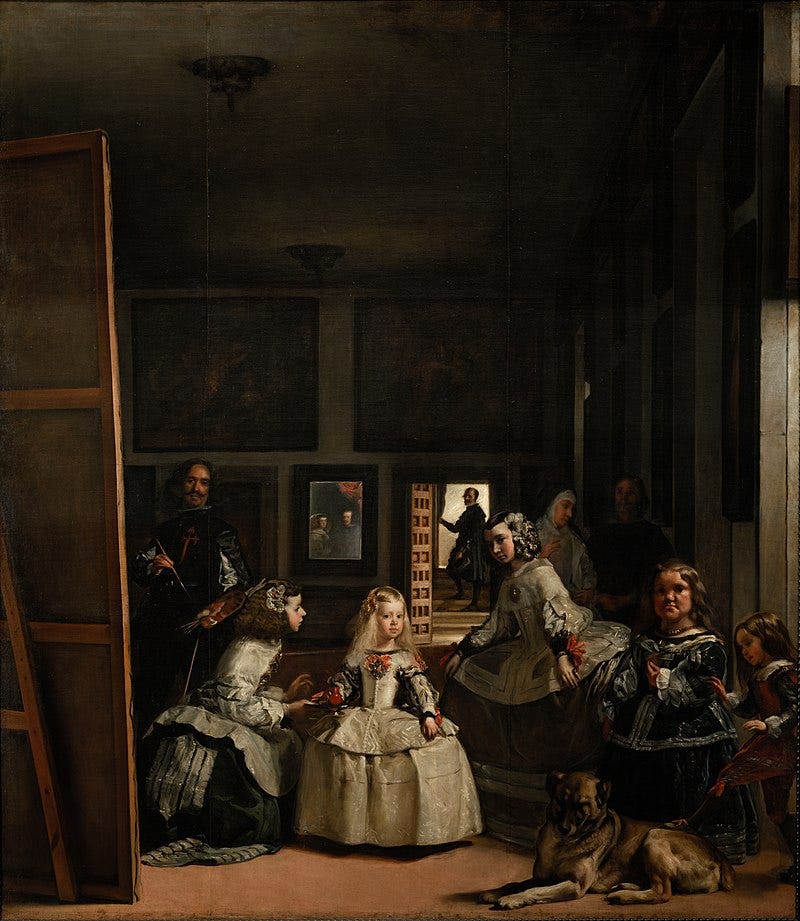welcome to cloudtopia
In this week’s newsletter, you’ll find enclosed reflections from my visits to art museums in the past few months, and in particular my recent visit to the Museo Nacional del Prado in Madrid, which I visited back in february, plus some art and reading recommendations :)
This was not my first time in the Prado, but each time I visit, the experience is different, yet always memorable and awe inspiring. I am a massive fan of museums generally, and the Prado is one of my favourite museums in the world, and contains some of my favourite paintings; yet as an institution and a space to experience works of art, it exemplifies aspects of both the best and the worst of art museums.
Today, I want to think through these things a little bit by discussing the weird and often panopticon-like atmospheres cultivated by Museum Spaces, and to share a few of my favourite ever paintings and the way that the spatial and communal experiences of visiting a museum can influence how we view them.
the art of the panopticon
In any museum space today, access remains a huge issue. Financial, physical, social, and cultural barriers around museums can be difficult to penetrate, and there is a lot of work to be done before museums can be spaces for all people to encounter art and history.
Who is a museum ‘for’? What kinds of activity and engagement are allowed within the space? What is the purpose of these spaces, and who gets to be the viewer in an art gallery?
In recent decades, these questions of the museum have been given much greater consideration, and access to art is increasingly democratised. Yet at the same time, barriers to access - physical, financial, and social - remain very much in place, and the outdated understandings around museums and their visitors continue to play a role.
One of the most interesting ways in which museum spaces are often intentionally designed in elitist and exclusive ways is through the implementation of surveillance and security theatre.
While some degree of the security apparatus of a museum exists to protect the art contained within, there is also a lot about it that operates on a more social level. The prevalence of guards, cameras, etc. in galleries ensure that guests maintain specific standards of behaviour, and the awareness of being watched reminds visitors of their status within this space, and encourages strict regulation of behaviour - movement, sound, use of technology - to control how people engage with the institution and the works of art in a space. Museums become more and more panopticon-like as surveillance becomes more all encompassing, and visitors remain under watch everywhere in the museum, regardless of the presence of an actual guard.
In the Prado, I thought a lot about these ideas around museum surveillance and the panopticon, something I’ve read a lot about in art history classes before. I am representative in some ways of the classical museum goer — I have the financial means to buy a ticket, I speak the language(s) that information is provided in, I have been educated in art and have the degree to prove it and I know the typical ways viewers are expected to quietly contemplate the work — and these are all things that make museums more accessible to me. But I often find myself hyperaware of the sense of surveillance in these spaces and of being watched, of having to perform good viewership for the watchful eye of the institution. Throughout my visit, I noticed it — the disdainful gaze of guards, the way that they regulated the movement of people through rooms and actively, somewhat agressively ensured we kept our distance, the way that sometimes when visitors conversed the guards would go out of their way to shush them, the constant reprimanding and chasing after to stop people taking photos, etc.
There is a total regulation of behaviour and movement in the galleries, all of which serves to remind us viewers that our presence in the space is conditioned, that we are guests in this place that is too great and important for us. Even the regulation of photography1 really only exists as an elitist prohibition to prevent people from engaging with work in certain ways deemed less than. Exclusivity is prioritised in a way that, practically, leads to more confused or unhappy visitors, and disruptions to the environment of the gallery are caused by guards shouting at and chastising people. These rules designed to preserve the status of the institution often work against themselves and instead infringe upon the experiential environment of the art space.
The means by which museum spaces and social rules are designed are really fascinating, and the sense of panoptic surveillance is just one of many sociological tools in the arsenal of museums and similar institutions to ensure spatial, social, and ideological authority is maintained. One of the touchstone pieces of writing that helped me learn to think critically about these spaces is Brian O’Doherty’s Inside the White Cube: The Ideology of the Gallery Space. From the introduction:
The eternity suggested in our exhibition spaces is ostensibly that of artistic posterity, of undying beauty. of the masterpiece. But in fact it is a specific sensibility, with specific limitations and conditionings, that is so glorified.
This text’s primary interest is modernism, and the modernist sensibilities that popularised and inaugurated the titular “white cube” as the now almost universal space of exhibition, but its interrogation of the ways in which we are trained to see and understand art and the tenuous and complex relationships between ‘art’, ‘viewer’, and the spaces and contexts in which they are formed. These relationships are intimately connected with the regulation of behaviour, and access to museums, enacting an almost ritualistic mode of experience within that sacred space.
The ideal gallery subtracts from the artwork all cues that interfere with the fact that it is “art.” The work is isolated from everything that would detract from its own evaluations of itself. This gives the space a presence possessed by other spaces where conventions are preserved through the repetition of a closed system of values. Some of the sanctity of the church…. joins with chic design to produce a unique chamber of esthetics. So powerful are the perceptual fields of force within this chamber that, once outside it, art can lapse into secular status.2
Museums are very much akin to sacred spaces, where placemaking is enacted and reaffirmed through specific conventions and forms of engagement. And museums often demand control in order to enact their missions. Their architecture demands conformity, their institutions look down on us, their very essence wants to ensure that we know we are Experiencing Art and exactly what Art is and can be.
art, alive.
But there is something to all of this, right? — something mystical about what O’Doherty refers to as the “sacramental nature” of visiting a gallery or a museum?
The Prado is one of my favourite museums in the world, and within it is one of my favourite gallery rooms, inside which is one of my favourite paintings. “Las Meninas”, painted in 1656 by Diego Velázquez, is a masterpiece.
The painting is massive in person, and takes up one wall of a huge, magnificent gallery room in the Prado’s main wing. The space of this room, which features a total of sixteen Velázquez paintings, largely portraits of and commissioned by the Spanish royal family, is full of an incredible, electric energy - this is the sacred space created when the conventions and components of the ideal gallery come together.
If you would like to view this space(or any others in the Prado!), digitally mediated, the Prado’s website has an incredible virtual collection where the rooms can be navigated and viewed google street view style. Las Meninas is found in room 12, a decagonal3 chamber with a domed ceiling of glass panels and beautiful, multicoloured marble floors.
I could stand in this room forever.
It is not just the massive scale and positioning of Las Meninas that commands such attention, although these certainly play a role. For me, it is the mystery of the painting that is so compelling, and the central puzzle is one that not only draws the attention of its viewers, but implicates us in its story and in a paradoxical, mutual gaze of seeing and being seen.
The painting depicts a group of figures recognisable from the spanish court at the time, including the painter himself. In contrast to the majestically posed portraits on display throughout the rest of the room, Las Meninas captures a scene frozen in a moment - Velázquez is at his easel, in the midst of or preparing to begin a massive painting, the titular meninas(ladies in waiting) group around the central figure of Infanta Margarita Teresa, and other members of the household appear mid action in the scene. There is so much to look at and try to understand in this scene.
Inherently, there is something contradictory in it - why is Velázquez, painter of this painting, in the story? He is shown painting a large scale work, staring out at the viewer. Who is he painting? While the Infanta is the central figure in Las Meninas, she does not even appear in his line of sight, so clearly he is at work on something else. In the distance, a mirror reflects two more figures, the King and Queen of Spain. Seen only in reflection, they do not appear in the plane of the painting, but instead seem to be positioned in the same place as we are. Viewers of the scene before us, yet subjects of a painting themselves, they occupy a space both outside of and yet intricately woven into the image presented in this painting.
In trying to unlock the complex puzzle of this image, we as viewers become entangled in it ourselves. The figures in the painting seem to be looking at us, the monarchs stand in the room with us, Velázquez might be painting us.
On a busy day in the Prado, this room is absolutely packed with visitors. When I entered the room, I spotted Las Meninas first through the doorway, then only from across the room, dozens of heads in between me and the watchful gaze of the painting. I watched it like this for a while, as people moved in and out of the room, stepped closer to the work, crowded in front of it, and it felt like the painting was alive. Here were countless new subjects for the painted Velázquez’ painting, new faces to meet the eyes of the Infanta, to notice the reflected faces of her parents, to peer after the retreating man as he leaves through a doorway we ourselves cannot reach. By viewing this work we are viewed, brought into its story and the long past Madrid it captures. The spaces blend together, open up, we are all mingling in this room, viewer and viewed, painter and muse, object and subject. Ultimately, it is the visitor to the museum, who comes to view Las Meninas that is the key to its mysteries, not only by taking part in its extraordinary tableau, but simply in viewing the painting, engaging it, ascribing meaning to it — we bring the work to life.
In spite of strict prohibitions on photography, I did take a few sneaky photos, so I wanted to share some of those here, and share with you(aside from the Velázquez gallery, which is magnificent but too carefully monitored for me to photograph) more of my favourite encounters with the works of the Prado, the connections we make, and the entangled magic that keeps art alive.
Possibly my favourite in the entire collection is the Hieronymous Bosch triptych The Garden of Earthly Delights(1490-1510), a massive work full of endlessly bizarre and beautiful details and images. I spent nearly half an hour with this painting during my last visit, slowly looking at different parts of the triune image and uncovering as many of its funny and charming and creepy puzzle pieces as I could.
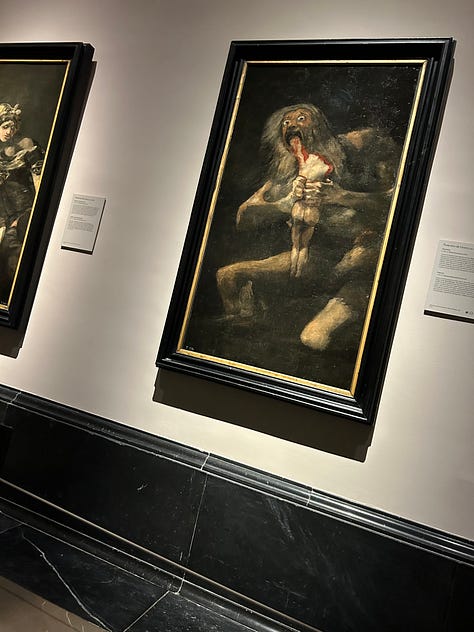
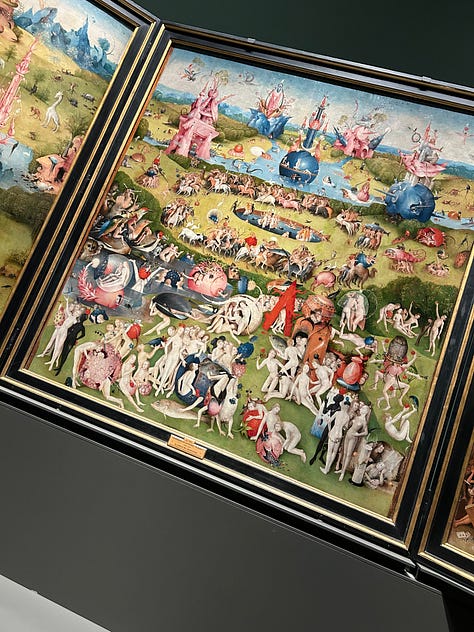

Besides the room that contains Las Meninas, my other favourite space in the Prado collects the “Black Paintings” of Francisco Goya4, including one of my all time favourites, Saturn(1820-1823)5, which is such a weird and unsettling and striking image. Last time I saw it, there was a small child who yelled “SATURNO” as soon as she saw this painting and seemed to absolutely love it, babbling about it to her father, who lifted her up to see it better. To some, this painting is horrific, to some it is a meme, and to others, it is an object of joy and fascination. This is part of what makes these museums so fun - you’re seeing not just the work, but the shared experiences of people and art in the space together, and these interactions give paintings life!
Goya’s works also appear in a poem by one of my favourites, Seamus Heaney:
Summer 1969
While the Constabulary covered the mob
Firing into the Falls, I was suffering
Only the bullying sun of Madrid.
Each afternoon, in the casserole heat
Of the flat, as I sweated my way through
The life of Joyce, stinks from the fishmarket
Rose like the reek off a flax-dam.
At night on the balcony, gules of wine,
A sense of children in their dark corners,
Old women in black shawls near open windows,
The air a canyon rivering in Spanish.
We talked our way home over starlit plains
Where patent leather of the Guardia Civil
Gleamed like fish-bellies in flax-poisoned waters.‘Go back,’ one said, ‘try to touch the people.’
Another conjured Lorca from his hill.
We sat through death-counts and bullfight reports
On the television, celebrities
Arrived from where the real thing still happened.I retreated to the cool of the Prado.
Goya’s ‘Shootings of the Third of May’
Covered a wall—the thrown-up arms
And spasm of the rebel, the helmeted
And knapsacked military, the efficient
Rake of the fusillade. In the next room,
His nightmares, grafted to the palace wall—
Dark cyclones, hosting, breaking; Saturn
Jewelled in the blood of his own children,
Gigantic Chaos turning his brute hips
Over the world. Also, that holmgang
Where two berserks club each other to death
For honour’s sake, greaved in a bog, and sinking.
He painted with his fists and elbows, flourished
The stained cape of his heart as history charged.
And nearly 55 years later I am still in awe of these galleries, still alive and vivid, terrible and holy.
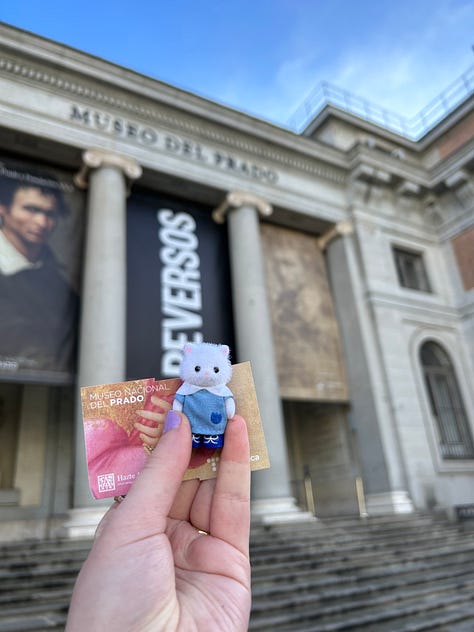
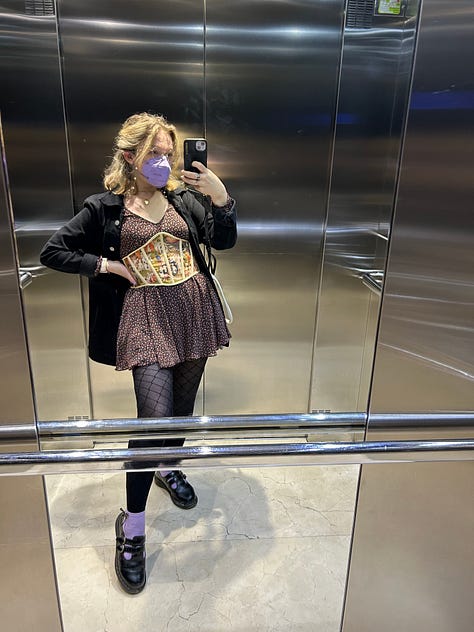
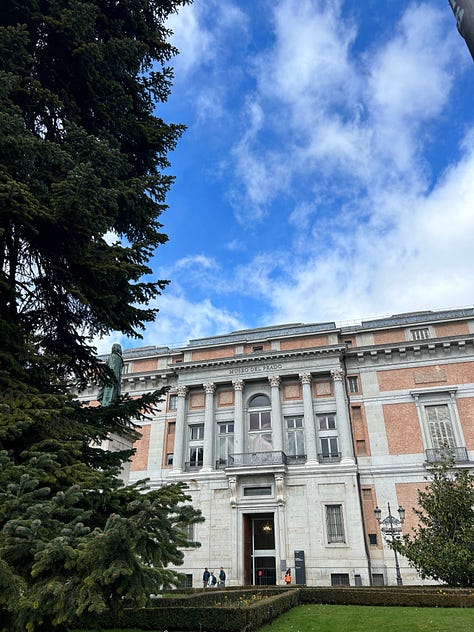
If you are new to cloudtopia, welcome! thank you for reading. I share weekly newsletters on art and pop culture, as well as personal reflections and recommendations. Please share this with a friend and feel free to get in touch or leave a comment — I would love to talk more about art, museums, your finds in the Prado virtual collection(seriously, I cannot recommend this enough), etc. !
from the white cube,
isobel
Some prohibitions have practical reasons - flash photography is almost universally not allowed in museum spaces due to the potential harm to many objects and works of art of light exposure - but a general ban on photography has only a cultural purpose, and is far less common.
One of Madrid’s other prominent museums, the Museo Nacional Centro de Arte Reina Sofia, has changed their rules to permit photography in recent years, and the presence of photography and camera phones has had no detrimental effect on the museum. I visited before the rule was changed(where we got yelled at in spanish at length for not knowing the rule) and again after(where the museum space was quiet and pleasant, and people felt free to look at and photograph the works)
Other European institutions of similar stature, like the Museé du Louvre, also permit photography, which has no ill effect on the museum’s control over patrons or its status as a top museum globally.
From O’Doherty, “Inside the White Cube”, page 14.
I think??
On the virtual tour: floor 0, room 67 if you want to check these out
This is often referred to as “Saturn Devouring His Son”, but I am going with the shorter title used by the Prado





